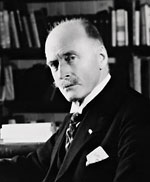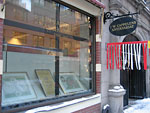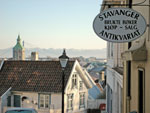Ibsen, Hamsun, and a Tiny Smoked Fish
Interpretive skills are needed when it comes to Grimstad’s other author, Knut Hamsun, who lived at nearby Nørholm farm from 1918 until his death in 1952.
Probably Norway’s second best–known writer, Hamsun made his mark with Hunger (1890), a pioneering work of literary modernism, and received the Nobel Prize for literature in 1920. The year 2009 is the 150th anniversary of his birth, a date that is being marked in more subdued fashion than the worldwide festivities commemorating the 100th anniversary of Ibsen’s death in 2006. The reason: Hamsun was a Nazi sympathizer, a prominent supporter of the German occupation of Norway during World War II. He visited Hitler in Germany and even presented his Nobel Prize to Goebbels. After the war he was put under house arrest and eventually tried for treason (he was acquitted, but fined).
The 150th anniversary has made it clear that Hamsun won’t go away. The National Library is organizing exhibitions and other official events. Scheduled to open in August is the Hamsun Center in Hamarøy, where Hamsun spent his youth; it’s a major architectural commission by Steven Holl Architects.
Located north of the Arctic Circle, Hamarøy is well off the beaten path. By contrast, Grimstad is a popular destination with a long-established literary attraction. The town already presents Hamsun in two guides to country walks inspired by his last book, På gjengrodde Stier [On Overgrown Paths], 1949. And now, from overgrown paths to highly visible public space: Making news a few days before I arrived in Grimstad was the announcement that the place in front of the town’s public library would be named Hamsuns Plass. Plass, not Gate (street), because while Henrik Ibsen streets are ubiquitous in Norway, public objections have made it impossible to name a street for Hamsun. The library will move to a new location, making the building available for a museum. The building itself was formerly the courthouse where Hamsun was on trial—an appropriately mixed message.
For both Grimstad and Stavanger, civic heritage has been determined by chance as well as intention. The poets’ town got lucky with Ibsen: he’s a figure everyone wants to celebrate. It’s not so easy with Hamsun, who reminds people that heritage is not just what you want to remember, it’s what you aren’t allowed to forget. Like it or not, today’s “pillars of society” have to deal with Hamsun. It’s a drama Ibsen surely would have appreciated.












 Erica Olsen is a freelance writer and a contract archivist at Edge of the
Cedars State Park Museum in Blanding, Utah. Her Norwegian roots are in
Stavanger and the Grimstad area.
Erica Olsen is a freelance writer and a contract archivist at Edge of the
Cedars State Park Museum in Blanding, Utah. Her Norwegian roots are in
Stavanger and the Grimstad area.